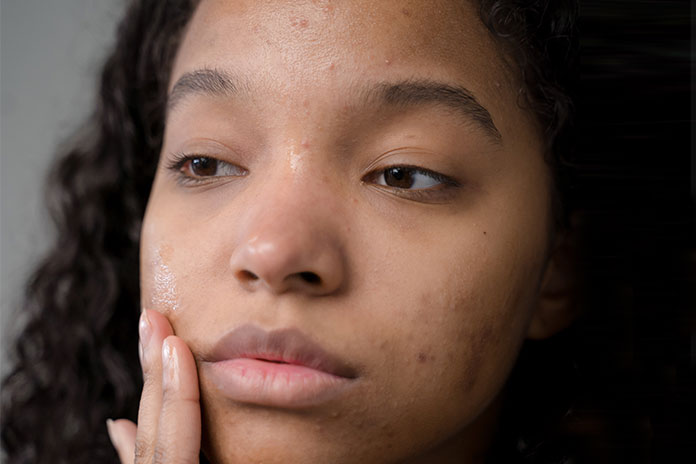Acne is a frequent skin pathology characterized by an inflammatory process of the hair follicle and the sebaceous gland (which produces sebum, the skin’s protective and lubricating fat). Its typical manifestations include various lesions, including “blackheads” or comedones and “pimples” or pimples that are inflamed (papules) or filled with pus (pustules).
Acne is frequent between the ages of about 13 and 20. It involves various factors in its onset: the hormonal structure, genetic factors and environmental factors, such as the presence of pollutants, lifestyle and probably also nutrition. It has been observed that juvenile acne is more prevalent in Western countries, while it has a very low prevalence in many developing countries; It has also been observed that the majority of acne increases in teenagers who move from developing countries to Western countries.
Although it is not a cause of disability, it often causes considerable psychological distress to those affected. In the event of acne onset, it is always important to consult an expert dermatologist and, if your doctor deems it appropriate, possibly an endocrinologist in cases of acne associated with overweight, excessive hair growth and irregular menstrual cycles (girls ) or early pubertal development (boys).
Nutritional habits are often cited among the most common causes of acne; however, many false beliefs on this subject are also widespread among issues with a high level of education. The confusion arises from the fact that, even in scientific literature, the possible role of diet in the pathogenesis of acne has yet to be fully clarified. Even if the scientific information we have still needs to be completed, it is nonetheless possible to suggest how to improve the diet-related component of acne without definitively eliminating specific foods from our table.
Table of Contents
General Dietary Recommendations
- Choose foods with a low glycemic index, as insulin resistance appears to be more associated with the development of juvenile acne.
- Choose foods low in saturated fat.
- Prefer cooking methods such as steam, microwave, grill or plate or non-stick pan, pressure cooker, rather than frying or boiling meat.
- Follow the recommendations for a balanced diet in the general population regarding the reduction of fats, especially of animal origin, drinks and foods rich in sugars and adequate portions of fruit and vegetables.
The following two chapters indicate the foods allowed in moderation, permitted and recommended in the case of the stated pathology. However, when following the instructions, one must take into account that, to obtain a correct and balanced diet that supplies the body with all the nutrients it needs, it is necessary to take the right quantity (portion) of the food and respect the frequencies with which some foods must be consumed, daily or weekly, within a personalized diet plan. The diet for the day must respect everyone’s energy balance, and the energy introduced must be equal to that expended in order not to increase the risk of overweight and obesity but also malnutrition.
Foods Allowed In Moderation
- Chocolate. Abundant consumption of chocolate could promote acne due to the high content of saturated fats and simple sugars, more than the cocoa itself.
- Milk. A very plentiful consumption is not recommended due to the possible scope of exogenous hormones and growth factors in the milk.
- Sweets such as creams, baked goods, especially if filled, ice creams, and candies because they are very rich in saturated fats and simple sugars.
- Pancakes, chips and other fried foods or foods rich in fat, such as buns linked to the onset of insulin resistance.
- Sugary drinks such as fruit juice, cola, tonic water…
- Spirits and spirits.
- Packaged foods. Evidence shows that the involuntary intake of some chemicals in plastic food packaging could contribute to insulin resistance and hormonal dysregulation.
Also Read: The Ultimate Guide To Skincare For Healthy, Glowing Skin
Allowed And Recommended Foods
- Raw and cooked vegetables are to be taken in generous portions. The variety in the choice allows you to correctly introduce the mineral salts, vitamins and antioxidants necessary for the body.
- Consume two to three medium-sized fruits daily (better eaten with the peel after washing them well).
- Whole grains. Alternate or, better still, replace refined cereals (pasta, rice, bread…) with wholemeal ones. This allows you to keep the glycemic index of the diet under control.
- Eat fish as a second course at least three times a week, alternating all types of fish, using frozen fish and occasionally, if necessary, canned fish, preferably natural. It appears that fish oils may be beneficial in treating acne.
- Legumes (at least two times a week).
- Lean red and white meat comes from lean cuts and is deprived of visible fat (a maximum of three times a week).
- Lean cold cuts such as defatted cooked or raw ham, bresaola or speck, up to 2 times a week.
- Cheese (twice a week instead of meat or eggs) prefers Grana Padano DOP because it contains 32% of unsaturated fats out of total fats.
Behavior Rules
- Practice regular physical activity (walk at least 30 minutes daily and exercise). Physical exercise also benefits the skin because it promotes blood flow to the epidermis and consequently contributes to cell regeneration, making the skin fresher and more alive. Movement contributes to the progressive slowing down of the signs of ageing.
- Not smoking! Smoking is one of the most potent factors in premature skin aging.
- Washing your face twice a day using warm water and a mild cleanser is good practice.
- Wearing make-up is allowed; on the contrary, in some cases, it helps to accept yourself. It is sufficient to use non-greasy, “oil-free” foundations or coloured creams, preferably recommended by a dermatologist. Do not use cleansing milk to remove make-up, but delicate but not greasy lotions.
- Tanning, whether natural or artificial, can temporarily camouflage acne, but it is not the cure for acne. Indeed, after the summer, there may be a resurgence of acne lesions, and there is even a type of acne with a summer onset. However, gradual exposure to non-greasy sunscreens decreases the skin’s oiliness and gives a healthy colour, which improves, if nothing else, the mood.
- In the event of overweight or obesity, it is recommended to reduce the weight and the “waistline”, i.e. the abdominal circumference, an indicator of the quality of fat deposited at the visceral level (see ” Overweight ” sheet). Adipose tissue is an organ that actively participates in the hormonal structure. Returning to an average weight allows you to reduce hormonal dysregulations and cardiovascular risk factors.
- Monitor body weight to prevent weight gains that may cause hormonal imbalances, which are involved in the pathogenesis of acne.
Practical Tips
In order not to exceed the consumption of dairy products – but simultaneously satisfy the need for calcium, which increases in adolescence – a 200 ml portion of milk or a 125 g jar of yoghurt can be consumed daily, preferably at breakfast. Add a spoonful of grated Grana Padano DOP to the first courses instead of salt. Limit your consumption of butter.
For a snack, I prefer fresh fruit, bread and jam.
Also Read: Acne: Which Plants Internally?


